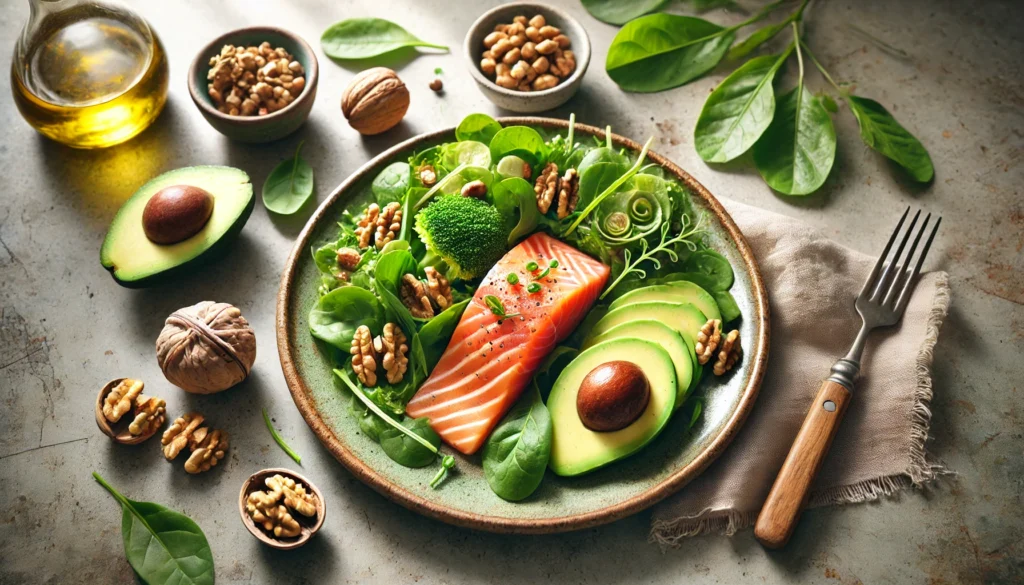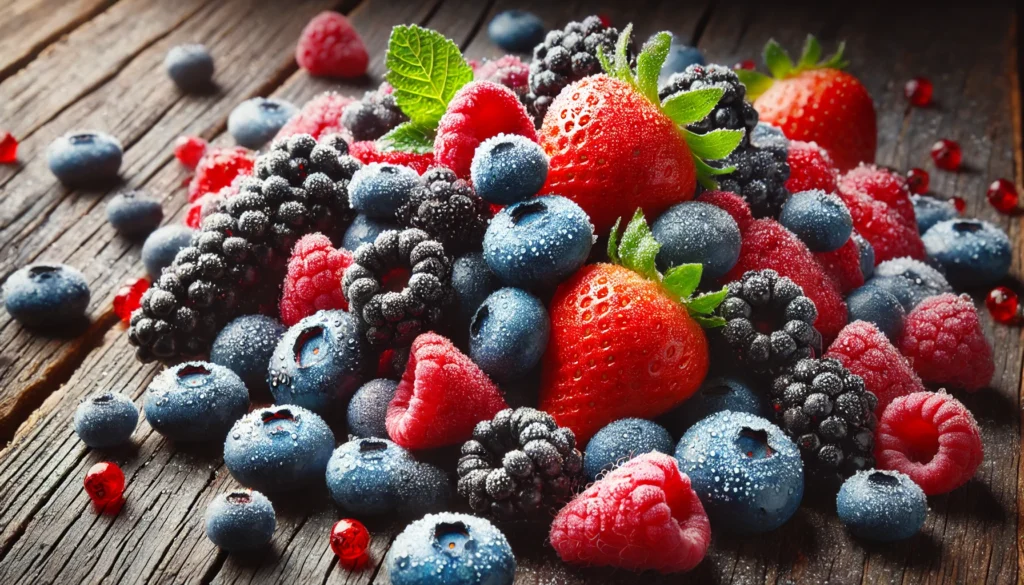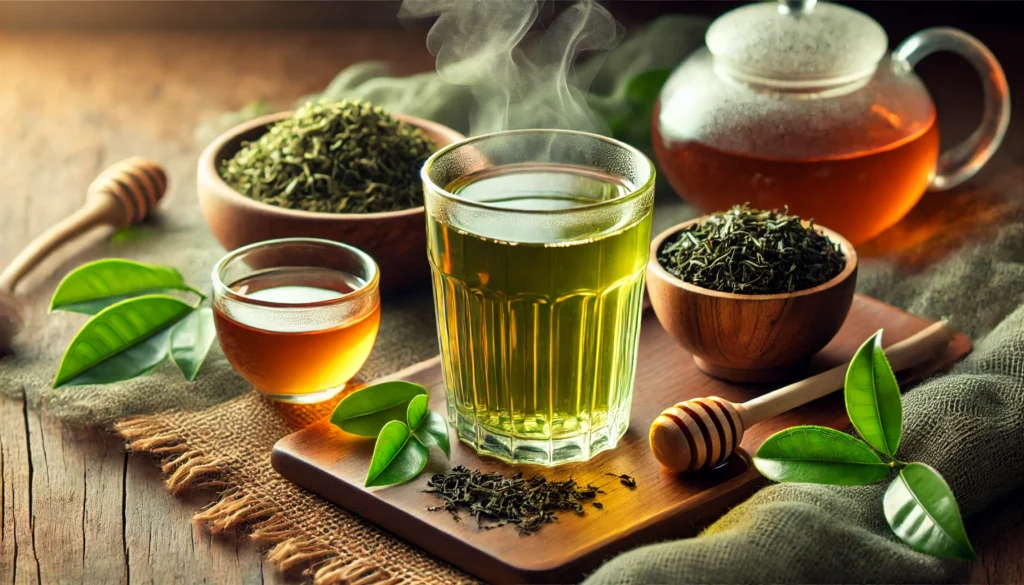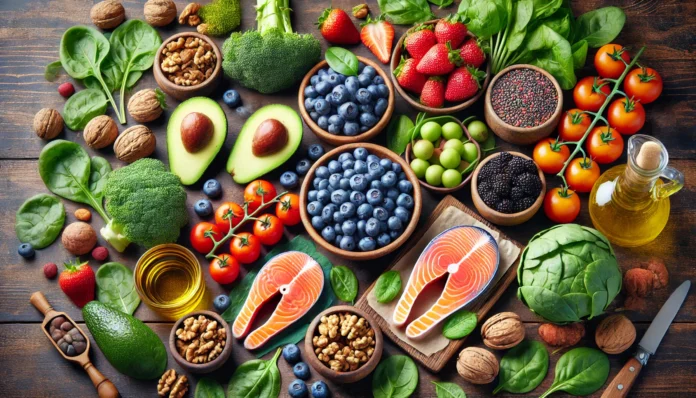Aging is a natural part of life, but the right diet can help slow down its visible effects, especially when it comes to the health and appearance of your skin. What you eat significantly influences skin elasticity, hydration, and overall vibrancy. Nutrient-rich foods filled with antioxidants, vitamins, and healthy fats play an essential role in maintaining youthful, radiant skin while helping to reduce the formation of fine lines and wrinkles. This article explores the best anti-aging foods that you should incorporate into your daily diet to fight wrinkles and keep your skin youthful.
You may also like: Top 10 Superfoods of 2022: Eat These To Live Better and Longer
The Science Behind Aging and Nutrition
As the body ages, it undergoes several biological changes, including decreased collagen production, reduced skin elasticity, and increased oxidative stress. These factors contribute to the formation of wrinkles, sagging skin, and dullness. However, consuming the right nutrients can counteract these effects and support skin regeneration. A well-balanced anti-aging diet is rich in antioxidants, healthy fats, and collagen-boosting ingredients that protect skin from damage and enhance its natural healing properties. Certain foods contain compounds that help reduce inflammation, neutralize free radicals, and stimulate collagen synthesis, ultimately slowing the aging process at a cellular level.
The Role of Antioxidants in Fighting Aging
Antioxidants are compounds that protect cells from oxidative stress, one of the leading causes of premature aging. Free radicals, which are unstable molecules generated by environmental pollutants, UV radiation, and even metabolic processes, contribute to cell damage. When free radicals accumulate, they cause inflammation and accelerate the breakdown of collagen, leading to wrinkles and sagging skin. Antioxidants found in various foods help neutralize these free radicals, reducing the signs of aging and promoting a healthier complexion.
Fruits, vegetables, nuts, and seeds are rich sources of antioxidants such as vitamin C, vitamin E, beta-carotene, and polyphenols. These nutrients not only combat oxidative damage but also enhance skin’s resilience against external stressors, helping it maintain a youthful glow for longer.

Top Anti-Aging Foods for Youthful Skin
1. Avocados: The Skin-Enhancing Superfood
Avocados are one of the most potent anti-aging foods, packed with healthy monounsaturated fats that keep skin hydrated and plump. The rich presence of vitamin E in avocados helps combat oxidative stress while supporting skin repair and renewal. Additionally, they contain vitamin C, an essential nutrient for collagen production, which helps maintain the skin’s elasticity and firmness.
Regular consumption of avocados can significantly improve skin texture, reducing dryness and preventing premature wrinkles. The combination of essential fatty acids and antioxidants provides long-lasting hydration, making the skin look supple and vibrant. Adding avocados to salads, smoothies, or whole-grain toast is an easy and delicious way to support skin health.
Avocados are also a natural source of vitamin D, which plays a role in skin cell growth and repair. This fat-soluble vitamin is essential for maintaining a healthy skin barrier and can be obtained through dietary sources like avocados.
2. Berries: Antioxidant Powerhouses
Berries such as blueberries, strawberries, raspberries, and blackberries are rich in antioxidants and polyphenols that protect the skin from oxidative damage. These vibrant fruits contain high levels of vitamin C, which is crucial for boosting collagen and repair the skin.
The anthocyanins in berries help reduce inflammation and enhance circulation, ensuring that the skin receives adequate oxygen and nutrients. This, in turn, promotes a more even skin tone and reduces the appearance of fine lines. Consuming a variety of berries daily can provide the skin with powerful anti-aging benefits, helping to maintain its youthful radiance and resilience.
3. Fatty Fish: Omega-3s for Wrinkle Prevention
Fatty fish like salmon, mackerel, and sardines are excellent sources of omega-3 fatty acids, which are essential for maintaining skin elasticity and hydration. Omega-3s help strengthen the skin’s lipid barrier, preventing moisture loss and reducing inflammation that contributes to aging.
The high concentration of astaxanthin in salmon, a powerful antioxidant, has been shown to improve skin elasticity and reduce the appearance of fine lines and wrinkles. Additionally, fish provides high-quality protein, which is necessary for the regeneration and repair of skin cells. Regularly consuming fatty fish can help keep the skin firm, smooth, and well-nourished from the inside out.
Fatty fish also contribute to cardiovascular health by lowering triglycerides and bad cholesterol levels. This dual benefit makes them a heart-smart and skin-friendly choice.
4. Nuts and Seeds: Collagen-Boosting Nutrients
Nuts and seeds, such as almonds, walnuts, chia seeds, and flaxseeds, are packed with vitamins and minerals that support skin health. Almonds are an excellent source of vitamin E, which helps protect the skin from UV damage and oxidative stress. Walnuts provide omega-3 fatty acids, which reduce inflammation and help maintain skin elasticity.
Chia and flaxseeds are particularly rich in alpha-linolenic acid (ALA), a plant-based omega-3 that supports skin hydration and reduces the formation of wrinkles. Incorporating a variety of nuts and seeds into your diet provides essential nutrients that strengthen the skin barrier and enhance its natural glow. They also make excellent heart-healthy snacks that support circulation and reduce the risk of chronic disease.
5. Dark Leafy Greens: Nutrient-Dense Skin Protectors
Dark leafy greens such as spinach, kale, and Swiss chard are loaded with vitamins, minerals, and antioxidants that promote youthful skin. These greens are excellent sources of vitamin A, which plays a crucial role in skin cell regeneration and repair. They also provide vitamin C, which boosts collagen production, and vitamin K, which helps reduce dark circles and improve skin tone.
The high fiber content in leafy greens supports gut health, which is directly linked to skin clarity and reduced inflammation. For additional gut and skin health benefits, pair leafy greens with oatmeal, another fiber-rich food that supports digestion and detoxification. In addition to heart health benefits, oatmeal’s beta-glucans help reduce inflammation and keep skin balanced from within.
6. Green Tea: A Natural Elixir for Youthful Skin
Green tea is renowned for its high levels of catechins, powerful antioxidants that protect the skin from UV damage and premature aging. The polyphenols in green tea help reduce inflammation and improve skin hydration, making it a valuable addition to any anti-aging diet.
Drinking green tea daily provides skin with protection against oxidative stress while promoting a healthy, even complexion. The presence of epigallocatechin gallate (EGCG), a potent antioxidant in green tea, helps slow the breakdown of collagen, ensuring that the skin remains firm and elastic over time.
7. Dark Chocolate: A Delicious Anti-Aging Treat
Dark chocolate, particularly those with high cocoa content (70% or more), is rich in flavonoids that enhance skin hydration and improve circulation. The antioxidants in dark chocolate protect the skin from UV-induced damage and improve its overall texture and resilience.
The anti-inflammatory properties of dark chocolate help reduce redness and irritation, making it a skin-friendly treat that supports a youthful appearance. Enjoying a moderate amount of high-quality dark chocolate can provide powerful anti-aging benefits while satisfying your sweet tooth.
8. Olive Oil: A Mediterranean Secret for Ageless Skin
Olive oil, a staple in the Mediterranean diet, is one of the best anti-aging foods for the skin. It is loaded with polyphenols and monounsaturated fats that help keep the skin hydrated and elastic. The anti-inflammatory properties of olive oil reduce redness and irritation, contributing to a healthier complexion.
Regular consumption of extra virgin olive oil can help protect the skin from premature aging, improving moisture retention and reducing the appearance of wrinkles. Drizzling olive oil over salads, vegetables, or using it as a cooking base can enhance both flavor and skin health.
Beyond skincare, olive oil supports cardiovascular health by helping to lower blood pressure and cholesterol. Its benefits extend throughout the body, making it a cornerstone of a longevity-promoting diet.

Frequently Asked Questions (FAQ) on Anti-Aging Foods
1. How do anti-aging foods benefit the skin beyond reducing wrinkles?
Anti-aging foods do more than just minimize wrinkles—they enhance skin elasticity, improve hydration, and protect against environmental damage. Many foods that fight aging contain antioxidants, which neutralize free radicals and reduce oxidative stress, a primary factor in premature aging. Additionally, certain anti-aging superfoods promote collagen production, which keeps skin firm and youthful. Consuming foods that reverse aging can also help reduce inflammation, which is a major contributor to dull and sagging skin. Incorporating the best anti-wrinkle foods into your diet can lead to a more radiant complexion and overall skin health.
2. Can an anti-aging diet improve other aspects of health?
Yes, adopting the diet that could slow down aging also supports overall well-being, including brain function, heart health, and immune resilience. Many anti-aging foods for skin, such as leafy greens, berries, and fatty fish, contain essential nutrients that enhance cognitive abilities and reduce the risk of neurodegenerative diseases. The best anti-aging foods are also rich in omega-3 fatty acids, which can improve cardiovascular health and reduce inflammation throughout the body. Many of these foods also help stabilize blood sugar and lower cholesterol, which are key to reducing the risk of age-related diseases. Choosing such foods provides a dual benefit for both skin and metabolic health.
3. What role do antioxidants play in fighting aging?
Antioxidants are crucial in foods that fight aging skin because they combat oxidative stress and cell damage. Free radicals—unstable molecules that contribute to aging—can lead to wrinkles, fine lines, and age-related diseases. Anti-wrinkle foods to eat, such as dark chocolate, nuts, and berries, are rich in antioxidants like vitamin C, vitamin E, and polyphenols. These nutrients protect skin cells from UV damage, environmental pollutants, and internal stressors. Including anti-wrinkle fruits in your diet ensures that your skin remains vibrant and youthful for longer.
4. How can diet impact skin hydration and elasticity?
Hydration and elasticity are essential for youthful skin, and an anti-aging diet can significantly enhance both. Foods that reduce wrinkles, such as cucumbers, watermelon, and avocados, have high water content and healthy fats that lock in moisture. Omega-3 fatty acids found in salmon and walnuts help maintain the skin’s lipid barrier, preventing dehydration and sagging. Additionally, anti-aging foods for skin rich in hyaluronic acid-boosting nutrients, like soy and sweet potatoes, can improve skin’s ability to retain moisture. Obtaining vitamin D naturally through food and sunlight also supports skin hydration and regeneration. This essential vitamin plays a vital role in maintaining a healthy, elastic skin barrier.
5. Are there specific foods that slow aging in different parts of the body?
Yes, different anti-aging superfoods target specific areas of the body. For brain health, blueberries and walnuts are top anti-aging foods that enhance memory and cognitive function. For joint health, foods that stop wrinkles, like turmeric and ginger, also reduce inflammation in the body. For heart health, anti-wrinkle foods such as dark leafy greens and fatty fish lower bad cholesterol and improve circulation. Foods that fight aging skin, like tomatoes and carrots, provide essential nutrients for sun protection and collagen production. A well-balanced diet incorporating these foods ensures comprehensive anti-aging benefits.
6. Can anti-aging foods help with hormonal balance?
Yes, the best anti-aging foods support hormonal balance, which plays a critical role in skin health and overall well-being. Certain anti-wrinkle foods for the skin, such as flaxseeds and soy, contain phytoestrogens that help regulate estrogen levels. Foods that reverse aging skin, like avocados and nuts, provide healthy fats that support hormone production. Leafy greens and whole grains stabilize blood sugar levels, preventing insulin spikes that can accelerate aging. By focusing on foods to eat to prevent wrinkles, you can maintain a stable hormonal balance that supports a youthful appearance.
Some anti-aging foods also promote hormonal and vascular health in men, helping to support sexual function and vitality. Several of these foods are associated with reduced risk of erectile dysfunction due to their positive effect on circulation and testosterone balance.
7. How can someone incorporate anti-aging foods into their daily meals?
Incorporating top anti-wrinkle foods into your diet doesn’t have to be complicated. Start the day with a smoothie packed with anti-wrinkle fruits like blueberries and pomegranate seeds. For lunch, opt for a salad rich in leafy greens, avocado, and nuts—foods that reduce wrinkles and nourish skin cells. Dinners can include grilled salmon or tofu with quinoa and roasted vegetables, which are loaded with nutrients found in the best anti-aging foods. Snacks like dark chocolate, almonds, and green tea further support skin health. Small dietary adjustments can make a significant impact on slowing the aging process.
8. What are some underrated foods that prevent aging?
While many people focus on common anti-wrinkle foods to eat, several underrated foods also offer powerful anti-aging benefits. Seaweed is packed with iodine and antioxidants that support thyroid function and skin hydration. Mushrooms contain ergothioneine, a powerful antioxidant that protects against oxidative stress. Beets enhance blood circulation, ensuring vital nutrients reach skin cells. Legumes like lentils and chickpeas provide plant-based protein that maintains collagen structure. Exploring a variety of anti-aging foods ensures a diverse nutrient intake that supports longevity and youthful skin.
9. Are there specific cooking methods that preserve the anti-aging properties of food?
Yes, how you prepare foods that fight aging can impact their nutrient retention. Steaming and roasting vegetables help preserve antioxidants better than frying, which can introduce harmful free radicals. Consuming raw anti-wrinkle fruits and nuts maximizes their vitamin content. Cooking with olive oil instead of processed vegetable oils ensures that the healthy fats remain intact. Fermenting foods like yogurt and kimchi enhances probiotic benefits, which support gut health and indirectly improve skin. Choosing gentle cooking methods allows you to maximize the benefits of the best anti-aging foods.
10. How quickly can someone see the effects of an anti-aging diet?
The effects of an anti-aging diet vary depending on individual metabolism, existing diet, and overall health. Some people notice improvements in hydration and skin texture within a few weeks of eating foods that slow aging. Long-term benefits, such as fewer wrinkles, enhanced elasticity, and improved overall health, may take months to become fully visible. Consistency is key—eating anti-aging superfoods regularly ensures that your body receives continuous nourishment. By committing to foods that reverse aging skin, you can sustain a youthful appearance and enjoy long-lasting health benefits.

Conclusion: The Diet That Could Slow Down Aging
Incorporating anti-aging foods into your daily diet is one of the most effective ways to fight wrinkles and keep your skin youthful. A diet rich in antioxidants, healthy fats, and collagen-boosting nutrients provides long-term protection against oxidative stress and premature aging. By making smart food choices, you can maintain a radiant, youthful complexion and promote overall health for years to come. Prioritizing nutrient-dense foods is the key to slowing down aging from the inside out, ensuring that your skin remains vibrant, firm, and resilient over time.
skin rejuvenation diet, youthful skin foods, anti-inflammatory diet for skin, best foods for glowing skin, natural collagen boosters, healthy aging nutrition, superfoods for skin health, hydration-boosting foods, nutrient-rich diet for aging, best diet for skin elasticity, foods that promote skin firmness, vitamins for youthful skin, best foods for skin repair, omega-3 for skin health, antioxidants for skin glow, plant-based anti-aging diet, holistic nutrition for aging, healthy fats for skin, longevity diet tips, natural anti-aging remedies
Further Reading:
The Anti-Aging Diet: Foods for Youthful Skin
Best Anti-Aging Foods for Healthy and Youthful Skin
Top 12 Anti-Aging Foods for Younger-Looking Skin
Disclaimer
The information contained in this article is provided for general informational purposes only and is not intended to serve as medical, legal, or professional advice. While Health11News strives to present accurate, up-to-date, and reliable content, no warranty or guarantee, expressed or implied, is made regarding the completeness, accuracy, or adequacy of the information provided. Readers are strongly advised to seek the guidance of a qualified healthcare provider or other relevant professionals before acting on any information contained in this article. Health11News, its authors, editors, and contributors expressly disclaim any liability for any damages, losses, or consequences arising directly or indirectly from the use, interpretation, or reliance on any information presented herein. The views and opinions expressed in this article are those of the author(s) and do not necessarily reflect the official policies or positions of Health11News.


